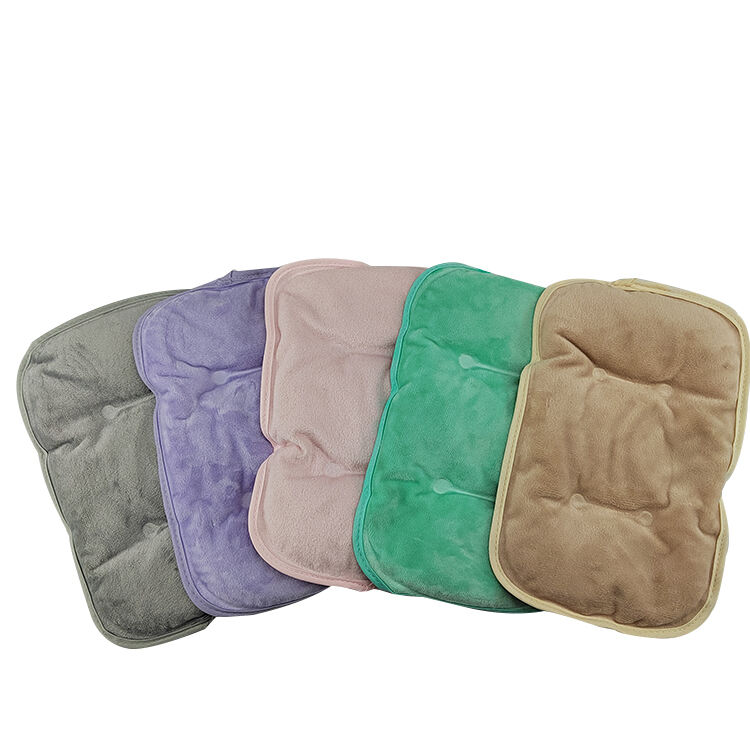Many people turn to heat therapy when their muscles start acting up because it works pretty well without all the hassle of pills or injections. People have used heat for ages in different ways like putting warm towels on sore spots or soaking in hot tubs. The idea is that warmth gets the blood flowing better and helps tight muscles loosen up. But there are some things folks need to watch out for with heat packs specifically. Don't want to end up with burns from leaving them on too long or setting them at too high a temperature. Most folks find that 15-20 minutes max is safest. Knowing what works and what doesn't makes all the difference between getting real relief and just wasting time. Safety first always pays off in the long run, even if it feels tempting to push through discomfort for faster results.
Proper Temperature - How to Avoid Burns and Skin Damage
Ideal Heat Range for Muscle Pain Relief
Getting the right temperature range matters a lot when using heat packs properly and without getting hurt. Most experts say the sweet spot falls somewhere between 104 degrees Fahrenheit and 113 degrees Fahrenheit, which translates to around 40 to 45 degrees Celsius on the metric scale. Sticking within these numbers helps relieve sore muscles without risking burns to the skin. Studies have shown again and again that keeping temperatures within this window protects against skin damage while still giving good therapeutic results. Take a look at findings published in medical journals recently they consistently point out that aiming for something warm instead of hot makes all the difference in reducing burn chances and actually making the treatment work better for people suffering from muscle pain.
Temperature Testing Methods
Testing the temperature before putting on a heat pack is really important for avoiding skin damage. There are several ways people do this check. Some folks grab a thermometer while others go old school with what they call the elbow test. Try pressing the pack against a spot that's extra sensitive, maybe the inside of your forearm, to see how it feels. A good rule of thumb? Warm those packs up just enough so they're comfortable, not scalding hot. And always give it a quick touch test with the back of your hand first. Taking these precautions makes all the difference in preventing burns or getting too much heat exposure from packs that might be set too high.
Barrier Use Between Skin and Heat Source
Putting something between the skin and whatever's generating heat really helps avoid direct contact and cuts down on the chance of getting burned. Old towels work great as barriers since they guard against burns while spreading out the heat more evenly over whatever part needs treatment. Look for fabrics that aren't too thin they let all the heat escape right away, but also don't go too heavy either because that just blocks the warmth completely. Most people find regular cotton works best for this purpose. Just remember this basic trick makes a world of difference when applying heat treatments safely at home without professional equipment.

Application Time - How Long Should Heat Packs Be Used?
Optimal Duration per Session
Most people find that applying heat therapy for muscle pain works best when done for around 15 to 30 minutes at a stretch. The warmth helps muscles loosen up and ease discomfort without risking injury. If someone just has some mild back tightness, 15 or 20 minutes usually does the trick. But folks dealing with really bad soreness might need closer to 30 minutes before they start feeling better. Medical studies back this up too showing that sticking to these time ranges gives good results while keeping burn risks low. Following these recommendations makes sense because it strikes a nice balance between getting real pain relief and staying safe during treatment.
Frequency Recommendations
How often someone applies heat packs matters just as much as how long they stay on. Most people find it works best to apply them about two or three times during the day. The skin needs time between sessions to cool down and avoid getting too hot. When dealing with long term issues, sticking with regular applications tends to make a difference. Spreading out the treatments helps maintain comfort levels throughout the day instead of just brief moments of relief. Doctors who specialize in pain management typically tell patients that finding this right balance between frequency and length of each session leads to better results while keeping the skin safe from burns or irritation. This approach gives folks more consistent control over their discomfort without putting their body at risk.
Recognizing Overuse Warning Signs
Too much heat therapy can actually backfire sometimes, so knowing what to watch out for matters quite a bit. When someone starts feeling more pain instead of relief, sees redness developing, or notices swelling after applying those heat packs, that usually means they've gone overboard either in frequency or duration. Our bodies tend to give pretty clear signals when something isn't working right, so stopping immediately makes sense once these warning signs pop up. Getting input from doctors or physical therapists helps tailor the approach based on individual needs, which keeps the good parts of heat therapy while avoiding any unwanted consequences. Staying mindful about how often and how long we apply heat lets most people get the comfort they need without running into problems down the road.
Fresh Injuries and Inflammatory Conditions
Putting heat on new injuries like sprained ankles or pulled muscles actually makes things worse, especially for people dealing with arthritis flare-ups too. Most folks don't realize this but heat packs should be avoided completely when there's fresh damage around. The reason? Heat tends to ramp up inflammation and can really mess with recovery time. When someone applies warmth to an area right after getting hurt, it causes blood vessels to expand which sends more blood flowing into already swollen tissue. This just makes the pain last longer and increases swelling unnecessarily. Doctors typically tell patients to stick with ice packs instead for these kinds of injuries. Cold helps bring down swelling fast and offers real relief without all the problems that come from heating up damaged tissues.
Medical Conditions Requiring Caution
Certain folks should be careful about trying heat therapy if they have particular health concerns. Things such as diabetes, being pregnant in early stages, or heart problems can turn regular heat treatments into something dangerous. Take diabetics for instance many struggle with damaged nerves which makes it hard to notice when skin gets burned or develops sores from prolonged heat exposure. Pregnant ladies also face special risks since too much warmth during pregnancy might affect both them and their babies negatively. And then there's the issue with people who already have heart conditions. When these individuals get heated up, sometimes their blood pressure reacts in ways doctors wouldn't recommend. That's why talking to a doctor first before grabbing those heat packs really matters. It helps avoid all sorts of complications down the road.
Impaired Sensation or Circulation Issues
People with poor sensation or circulation problems need to be careful when using heat therapy. Someone who struggles to feel temperature changes could end up burned without even realizing it if the heating pad gets too hot. When there are circulation issues causing reduced blood flow, this actually makes things worse because heat tends to mess with circulation even more and can make whatever problem already exists get worse. That's why folks in this situation usually do better with cold packs instead or at least much gentler forms of heat application. And when using any kind of heat treatment, extra precautions make sense. Maybe put something like a towel between the skin and the heat source, or better yet talk to a doctor first about what's safest given their particular condition.
Conclusion - Best Practices for Safe Muscle Pain Relief with Heat Packs
To get the most out of heat packs for muscle pain relief, people need to follow some basic safety rules. Knowing exactly when and how long to apply heat makes all the difference in relaxing tight muscles and getting better blood flow. It's also important to know what not to do too. For instance, putting heat on a brand new injury or somewhere that's inflamed just creates more problems than solutions. Most folks forget about timing completely. A good rule of thumb is 15-20 minutes max per session, especially if dealing with chronic issues rather than acute pain. Stick to these simple guidelines and heat therapy becomes both safer and way more effective over time.
FAQ
What is the ideal temperature range for heat packs?
The ideal temperature range for heat packs is typically between 104°F to 113°F (40°C to 45°C) to ensure effective muscle pain relief while minimizing the risk of burns.
How often should heat packs be used?
Heat packs are generally recommended for use two to three times a day to manage ongoing discomfort while allowing the skin to recover between sessions.
What are signs of overusing heat therapy?
Signs of overusing heat therapy include increased pain, redness, or swelling after application. It's crucial to stop the therapy if these signs appear and consult a healthcare provider.
Are there any conditions where heat packs should be avoided?
Heat packs should be avoided on fresh injuries, inflammatory conditions, and with specific medical conditions such as diabetes and cardiovascular disorders without consulting a healthcare provider.

